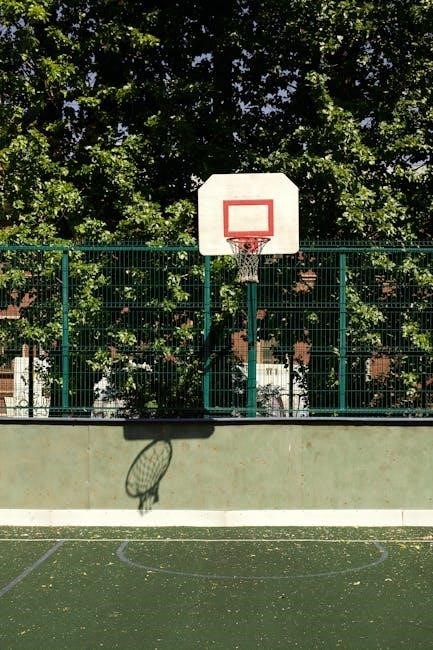
basketball practice plan template pdf
A basketball practice plan template PDF is a structured guide helping coaches organize drills, time management, and skill development effectively, ensuring productive and focused team training sessions.
1.1 What is a Basketball Practice Plan Template?
A basketball practice plan template is a pre-designed document that outlines the structure and content of a training session. It typically includes sections for warm-ups, drills, scrimmages, and cool-downs, ensuring coaches cover all essential aspects of player development. Available in PDF format, these templates are customizable, allowing coaches to tailor activities to their team’s needs. They also often include space for notes and adjustments, making them versatile tools for organizing effective and efficient practices. Using a template helps coaches save time and ensures a balanced approach to skill development and teamwork.
1.2 Importance of Using a Practice Plan Template
Using a basketball practice plan template is crucial for ensuring efficient and organized training sessions. It helps coaches prioritize goals, allocate time effectively, and cover essential skills like dribbling, shooting, and defense. A well-structured template promotes consistency, allowing players to progress systematically and build teamwork. It also saves preparation time, enabling coaches to focus on execution during practices. Additionally, templates can be customized to suit different age groups and skill levels, making them versatile tools for coaches aiming to maximize player development and achieve team objectives effectively.
1.3 Benefits of PDF Format for Practice Plans
The PDF format offers numerous advantages for basketball practice plans. It ensures consistency and professional presentation, making it easy to share with assistants or players. PDFs are universally compatible across devices, eliminating formatting issues. They can be easily printed for on-court use, providing a tangible reference during training. Additionally, PDFs are secure and cannot be accidentally altered, preserving the integrity of the plan. Templates in PDF format also allow for easy customization, enabling coaches to tailor drills and activities while maintaining a clean, organized structure that enhances the overall coaching experience. This makes PDFs a practical choice for coaches at all levels.

Key Components of a Basketball Practice Plan
A well-structured basketball practice plan includes warm-ups, skills and drills, team huddles, scrimmages, and cool-downs, ensuring a balanced and productive training session for players of all levels.
2.1 Warm-Up Activities
Warm-up activities in a basketball practice plan are essential for preparing players physically and mentally. They typically include light cardio exercises like jogging, stretching, and dynamic movements to increase flexibility and reduce injury risk. Ball handling drills, such as dribbling and figure-eight exercises, also engage players and enhance dexterity. These activities set the tone for the session, ensuring players are ready to transition into more intense drills and gameplay scenarios. A well-structured warm-up is crucial for maximizing performance and preventing fatigue during practice.
2.2 Skills and Drills
Skills and drills form the core of a basketball practice plan, focusing on developing specific abilities like shooting, passing, and defense. Drills such as Maravitch ball handling exercises improve dexterity, while defensive rebounding drills enhance team defense. Shooting drills from the top of the key help players refine their accuracy and technique. These structured activities are designed to address individual and team needs, ensuring players build proficiency in key areas. By incorporating varied and targeted drills, coaches can create a balanced and effective practice that fosters player growth and prepares the team for game situations.
2.3 Team Huddle/Devotional
A team huddle or devotional is a brief session within practice to foster unity, motivation, and focus. Coaches often use this time to discuss team goals, review strategies, or inspire players with motivational messages. Some templates include space for reflection or short discussions, helping to build team chemistry and mental preparation. This moment also allows players to align their mindset, address challenges, and reinforce positive values. By incorporating a huddle or devotional, coaches create a supportive environment that strengthens team bonds and prepares players mentally for the upcoming drills and game situations.
2.4 Scrimmage and Game Situations
Scrimmage and game situations are pivotal in practice plans, allowing teams to apply skills in real-time scenarios. Coaches simulate game conditions to enhance decision-making, teamwork, and adaptability. Drills often include half-court or full-court scrimmages, focusing on offensive and defensive execution. Specific situations, such as end-of-game plays or fast breaks, are rehearsed to build confidence and tactical awareness. These exercises bridge the gap between drills and actual competition, ensuring players are prepared for various game challenges and can perform effectively under pressure. Incorporating these elements sharpens instincts and fosters a competitive yet disciplined mindset.
2.5 Cool-Down and Stretching
Cool-down and stretching are essential for injury prevention and recovery. A well-structured cool-down includes static stretches for hamstrings, quadriceps, and calves, along with dynamic stretches to gradually lower heart rates. This phase, lasting 10-15 minutes, helps flush out lactic acid and reduces muscle soreness. Coaches often incorporate breathing exercises and light cardio, such as jogging or walking, to transition players to a relaxed state. Proper stretching techniques are emphasized to maintain flexibility and mobility. Ending practice with a cool-down fosters a routine that prioritizes player well-being and prepares them for future sessions.

Structuring a Basketball Practice Plan
Effective practice plans balance warm-ups, skill drills, scrimmages, and cool-downs, ensuring a logical flow and time management to maximize productivity and player development, tailored to team needs.
3.1 Start Time and End Time
Clearly defining start and end times is crucial for effective practice planning. Coaches should schedule practices to ensure adequate time for warm-ups, drills, and cool-downs. A typical practice might run from 4:30 AM to 5:15 AM, allowing for a structured flow. Time management is key to covering all essential activities without rushing. Using a PDF template helps maintain consistency and ensures players and staff are aligned. Adhering to a set schedule promotes discipline and maximizes productivity, making every minute count toward achieving team goals. A well-organized timeline is essential for successful practice execution and player development. Proper planning prevents wasted time and keeps everyone focused.
3.2 Activity Duration and Notes
Specifying activity duration ensures balanced practice. Allocate 5-10 minutes for warm-ups, 15-20 for drills, and 10 for cool-downs. Notes sections allow coaches to add tips like focusing on proper ball handling or defensive positioning. Using a PDF template helps track time and details efficiently, ensuring each activity is purposeful and aligned with team goals. This structure keeps practices organized and productive, allowing for adjustments as needed to optimize player growth and team performance. Clear notes and timings help maintain focus and achieve desired outcomes. Proper documentation ensures consistency and accountability.
3.3 Balancing Offensive and Defensive Drills
Balancing offensive and defensive drills is crucial for well-rounded player development. Allocate equal time to both, ensuring players master scoring and stopping opponents. Offensive drills might include shooting and ball-handling exercises, while defensive drills focus on rebounds and positioning. A PDF template helps structure these elements, ensuring practices are comprehensive and effective. This balance fosters versatility and prepares teams for game situations, enhancing overall performance and strategic execution. Proper allocation of time ensures both sides of the game are strengthened, leading to a competitive edge. A balanced approach is key to building a formidable team.

Customizing Your Practice Plan
Customizing your basketball practice plan template PDF allows coaches to tailor drills, adjust for skill levels, and incorporate team goals, ensuring focused and effective training sessions.
4.1 Tailoring Drills for Different Age Groups
Tailoring drills for different age groups ensures age-appropriate skill development. For younger players, focus on basic skills like dribbling and shooting through fun, engaging activities. For high school and older groups, incorporate more complex drills and game situational exercises. Adjusting time allocations and intensity levels helps meet the needs of each age group. Use the basketball practice plan template PDF to modify drills, ensuring they align with the developmental stage of your players; This approach fosters engagement, skill improvement, and prepares players for competition while maintaining a balanced and effective practice structure.
4.2 Adjusting for Skill Levels (Beginner, Intermediate, Advanced)
Adjusting drills for skill levels ensures players receive appropriate challenges. For beginners, focus on fundamental skills like basic dribbling and shooting. Intermediate players can handle more complex drills, such as combination moves and defensive techniques. Advanced players benefit from high-intensity, game-specific scenarios and strategic plays. The basketball practice plan template PDF allows coaches to tailor activities to match the skill level of their team, ensuring progression and engagement. This approach maximizes skill development, keeps practices dynamic, and prepares players for the next level of competition while maintaining a cohesive and effective training structure.
4.3 Incorporating Team Goals and Objectives
Incorporating team goals into a basketball practice plan template PDF ensures drills align with desired outcomes. Coaches can tailor activities to focus on improving specific areas, such as offensive plays or defensive strategies. By outlining clear objectives for each session, players stay focused and motivated. The template allows for assigning time and notes to each activity, ensuring a balanced approach to skill development. This structured method helps teams achieve their goals effectively, fostering productivity and progress in every practice, while maintaining a clear vision for the season ahead.

Popular Basketball Practice Plan Templates
Popular basketball practice plan templates include high school, youth, and college-level designs, offering structured drills and activities tailored to specific skill levels and team objectives in PDF formats.
5.1 High School Basketball Practice Plans
High school basketball practice plans are tailored to enhance teenage athletes’ skills, focusing on advanced drills, game strategies, and physical conditioning. These templates often include detailed warm-up routines, offensive and defensive drills, and scrimmage scenarios. They emphasize balancing individual development with team coordination, ensuring players are prepared for competitive matches. Many high school plans are available in PDF formats, offering structured yet flexible frameworks for coaches. They typically include time management guides, activity durations, and notes sections for customization. These plans are essential for building a cohesive and skilled team at the high school level.
5.2 Youth Basketball Practice Plan Templates
Youth basketball practice plan templates are designed for young athletes, focusing on skill development, teamwork, and fun. These PDF templates include age-appropriate drills, simplified strategies, and engaging activities to keep players motivated. They often feature structured warm-ups, fundamental skill-building exercises, and small-sided games. Coaches can customize these plans to suit different age groups, ensuring activities are safe and suitable for developing players. The emphasis is on fostering a love for the game while improving basic basketball skills in a supportive environment. These templates are essential tools for youth coaches aiming to create a positive and educational experience.
5.3 College and Professional Practice Plans
College and professional basketball practice plans are highly structured and detailed, focusing on advanced skill refinement, tactical execution, and physical conditioning. These PDF templates cater to elite-level athletes, incorporating complex drills, game situational scenarios, and performance analytics. They emphasize strength and conditioning, positional-specific training, and mental preparation. Coaches at this level use these plans to fine-tune strategies, enhance teamwork, and prepare for competitive matchups. The templates often include video analysis, player tracking, and data-driven insights to optimize performance and achieve championship-level results, making them indispensable for high-level basketball programs.

Sample Practice Plans
Sample basketball practice plans provide ready-to-use templates for coaches, detailing warm-ups, drills, and scrimmages to maximize efficiency and skill development during training sessions.
6.1 Starter Practice Plan 1
The Starter Practice Plan 1 is a simple yet effective template designed for new coaches or teams. It includes a warm-up activity, team meeting, skills and drills, team huddle/devotional, scrimmage, and cool-down. The plan is structured with time blocks and notes sections to ensure organization. This template is ideal for introducing basic basketball concepts and building team chemistry. Coaches can easily customize it based on their team’s needs and progress. Its clear format makes it accessible for coaches of all experience levels, providing a solid foundation for practice sessions.
6.2 U18 Practice Plan Template
The U18 Practice Plan Template is tailored for intermediate-level players aged 12-13. It includes structured sessions focusing on skill development, team play, and physical conditioning. The template begins with a warm-up, followed by drills like Maravitch ball handling and defensive rebounding. Scrimmage and game situations are emphasized to prepare players for real-game scenarios. Each activity is timed, with notes for coaches to track progress and provide feedback. The plan also includes a team huddle for motivation and strategy discussion. This template is adaptable, ensuring practices are engaging and aligned with the team’s developmental goals. Coaches can modify it to suit their players’ needs.
6.3 YMCA Winners Basketball Practice Plan
The YMCA Winners Basketball Practice Plan is designed for youth players, focusing on skill development and character building. It starts with a warm-up and Maravitch ball handling drills, followed by offensive and defensive exercises. The plan includes a team huddle for motivational talks and ends with a cool-down. Coaches can adapt this template to suit different skill levels, ensuring each session is engaging and productive. The emphasis is on fostering teamwork and sportsmanship while improving basketball skills. This template is ideal for creating structured and enjoyable practices for young athletes. It aligns with the YMCA’s mission to develop well-rounded players.

Tools and Resources
Discover a variety of tools and resources for creating effective basketball practice plans. Utilize practice plan creators, printable forms, and professional scouting forms to streamline your coaching process and enhance team performance.
7.1 Basketball Practice Plan Creator
A Basketball Practice Plan Creator is an essential tool for coaches, offering templates and customization options to design structured and effective practice sessions. It allows coaches to easily organize drills, set time allocations, and focus on specific skills or strategies. Many creators include pre-designed templates that can be tailored to different age groups and skill levels. With features like drag-and-drop functionality and real-time editing, coaches can save time while ensuring practices are engaging and goal-oriented. Additionally, these tools often support PDF exports, making it easy to share plans with assistants or players. They are a must-have for modern coaches aiming to maximize efficiency and impact.
7.2 Printable Basketball Forms and Court Diagrams
Printable basketball forms and court diagrams are indispensable resources for coaches, enhancing organization and visualization during practice planning. These tools include player evaluation forms, game strategy sheets, and court layouts in various formats such as USA, NBA, and FIBA standards. Coaches can use these diagrams to map out plays, communicate strategies clearly, and ensure alignment with official regulations. The availability of these resources in printable formats allows for easy distribution and reference during training sessions. They complement practice plan templates by providing a comprehensive approach to team management and tactical execution, ensuring every aspect of the game is covered effectively.
7.3 Professional Scouting Forms
Professional scouting forms are essential tools for evaluating players and opponents, offering detailed frameworks to assess performance and identify strengths and weaknesses. These forms typically include sections for recording player statistics, skill evaluations, and game observations. Coaches and scouts can use them to track progress, prepare for games, and make informed decisions. Available in printable formats, they complement practice plan templates by providing actionable insights. Scouting forms ensure a systematic approach to talent evaluation, enabling teams to refine strategies and improve overall performance, making them a valuable asset in competitive basketball environments.

Drills and Exercises
Drills and exercises are crucial for skill development and team performance, including ball handling, defensive rebounding, and shooting exercises, progressing from basic to advanced, with detailed instructions in the PDF.
8.1 Maravitch Ball Handling Drills
Maravitch ball handling drills focus on improving dribbling skills through stationary and dynamic exercises. Players perform crossovers, figure-eight drills, and behind-the-back dribbles, progressing from basic to advanced. These drills emphasize hand-eye coordination, speed, and control. Coaches can incorporate timed sessions, such as 5 minutes for stationary work and 10 minutes for dynamic movements. The drills are structured to build confidence and precision, preparing players for game situations. Proper footwork and staying low are emphasized to maintain balance and protect the ball. These exercises are essential for developing guards and wing players.
8.2 Defensive Rebounding Drills
Defensive rebounding drills focus on securing the ball after a missed shot, minimizing offensive rebounds, and transitioning quickly to offense. Players practice positioning, timing jumps, and boxing out opponents. Drills include 1-on-1, 2-on-2, and 3-on-3 scenarios, simulating game situations. Coaches emphasize physicality, footwork, and awareness. Teams also work on outlet passes and fast breaks following rebounds. These drills improve team defense and create scoring opportunities, making them vital for competitive play. Proper rotation and communication are stressed to ensure all players contribute effectively to securing rebounds consistently during games.
8.3 Shooting Drills from the Top of the Key
Shooting drills from the top of the key focus on improving accuracy and consistency from this critical scoring position. Players start with catch-and-shoot exercises, progressing to off-the-dribble and contested shots. Drills often incorporate game-like scenarios, such as end-of-game situations or defensive pressure. Coaches emphasize proper footwork, balance, and follow-through. Players also practice shooting from different angles and distances, enhancing their versatility. These drills are essential for developing reliable scorers and improving team offensive efficiency, making them a staple in any basketball practice plan template.

Best Practices for Coaches
Coaches should emphasize clear communication, positive reinforcement, and adaptability. Cultivate teamwork, provide constructive feedback, and ensure drills align with team goals. Continuous improvement and player development are key priorities.
9.1 Cultivating Values Through Practice
Coaches play a crucial role in instilling values such as discipline, teamwork, and sportsmanship. Practice plans should incorporate activities that promote accountability and respect. Team huddles and devotionals can foster unity and focus. Drills that emphasize communication and trust build a strong team culture. Positive reinforcement and constructive feedback encourage resilience and growth. By integrating these elements, coaches can help players develop not only their skills but also their character, ensuring a well-rounded development both on and off the court.
9.2 Developing Team Chemistry
Building strong team chemistry is essential for success on the court. Coaches can foster this by incorporating team-building activities into practice plans, such as partner drills, small-group exercises, and scrimmages that encourage collaboration. Communication drills, like calling out plays or defensive switches, strengthen trust and coordination. Team huddles and post-practice discussions also promote unity and accountability. By creating opportunities for players to rely on each other, coaches can develop a cohesive unit that performs seamlessly together, translating into improved performance and a positive team culture. These efforts ensure players feel connected and invested in shared goals.
9.3 Providing Feedback and Encouragement
Effective feedback and encouragement are critical for player development. Coaches should provide specific, constructive comments during drills and scrimmages, highlighting strengths and areas for improvement. Positive reinforcement boosts confidence, while actionable advice helps players refine their skills. Incorporating one-on-one check-ins and team discussions in practice plans allows for personalized guidance. Encouraging a growth mindset fosters resilience and motivation. By balancing critique with praise, coaches create an environment where players feel supported and driven to excel, both individually and as a team.

Downloadable Templates
Downloadable basketball practice plan templates in PDF format offer convenience and structure. They include various options like starter plans, U18 templates, and YMCA practice guides for easy customization and implementation.
10.1 Free Basketball Practice Plan Templates
Free basketball practice plan templates in PDF format are widely available online, offering coaches flexibility and convenience. These templates are customizable to suit different team needs, age groups, and skill levels. Many include sections for warm-ups, drills, scrimmages, and cool-downs, ensuring comprehensive practice organization. Popular options like the YMCA Winners Basketball Practice Plan provide structured yet adaptable frameworks. Coaches can download and print these templates easily, saving time and enhancing practice efficiency. They are ideal for teams seeking affordable yet effective tools to plan and execute successful training sessions throughout the season.
10.2 PDF Practice Plan One-Pager
The PDF Practice Plan One-Pager is a concise, single-page template designed for coaches needing a streamlined approach. It includes essential sections like warm-up activities, skills and drills, scrimmage setups, and cool-down stretches. This format is ideal for quick reference during practices, ensuring coaches stay organized without unnecessary details. Many one-pagers are customizable, allowing adjustments for specific team goals or age groups. They are popular among youth and high school coaches who prefer simplicity and efficiency. Downloadable options are readily available, making it easy to access and implement effective practice planning on the go.
10.3 Full Practice Plan Instructions
The Full Practice Plan Instructions provide a comprehensive guide for coaches to design and execute effective training sessions. These instructions include detailed step-by-step layouts, timing recommendations, and tips for adapting drills to different skill levels. They often cover warm-up routines, skill development exercises, team play strategies, and cool-down stretches. Many templates also offer space for notes and adjustments, allowing coaches to tailor practices to their team’s specific needs. Available in PDF format, these instructions are easy to download, print, and use, making them a valuable resource for coaches of all experience levels.
Effective basketball practice planning is crucial for team success. Use these templates to organize drills, manage time, and enhance skills, ensuring productive and focused training sessions for optimal results.
11.1 Final Thoughts on Effective Practice Planning
Effective practice planning is the cornerstone of successful basketball coaching. A well-structured basketball practice plan template PDF ensures that each session is purposeful and aligned with team goals. Coaches should focus on balancing skill development, strategy, and teamwork while maintaining player engagement. By incorporating warm-ups, skills and drills, scrimmages, and cool-downs, a coach can create a comprehensive plan that fosters growth and prepares the team for game situations. Utilizing customizable templates saves time and allows for adaptability, making each practice efficient and impactful. Consistency and attention to detail in planning lead to improved performance and a cohesive team dynamic.
11.2 Encouraging Continuous Improvement
Continuous improvement is vital for both players and coaches. By regularly reviewing and updating practice plans, teams can address weaknesses and build on strengths. Coaches should encourage players to reflect on their performance and set achievable goals. Incorporating feedback and adjusting drills ensures progression. Utilizing resources like the Practice Plan One-Pager and PDF Practice Plan Full Instructions provides structured guidance. Emphasizing skill enhancement through drills like the Maravitch Ball Handling Drills and Shooting Drills from the Top of the Key fosters growth. Consistent effort and adaptability are key to long-term success.
11.3 Resources for Further Development
Coaches can access numerous resources to enhance their practice planning skills. Websites offer downloadable practice plan templates and guides, such as the U18 Practice Plan Template and YMCA Winners Basketball Practice Plan. Tools like the Basketball Practice Plan Creator simplify customization. Additionally, Printable Basketball Forms and Court Diagrams aid in organizing drills and strategies. Professional Scouting Forms help identify player strengths and areas for improvement. Leveraging these resources ensures coaches have the support needed to create effective, tailored practice plans for their teams. Continuous learning through these materials fosters a well-rounded and successful coaching approach.
Related Posts
multiplying and dividing integers pdf
Learn to multiply and divide integers with our easy PDF guide, complete with step-by-step examples and practice worksheets. Perfect for math learners!

clinical interviewing 6th edition pdf free download
Get instant access to Clinical Interviewing 6th Edition PDF for free. Download now and save time with our hassle-free service!

el hombre mas rico de babilonia pdf
Download the classic PDF guide to master wealth-building strategies and achieve financial success.